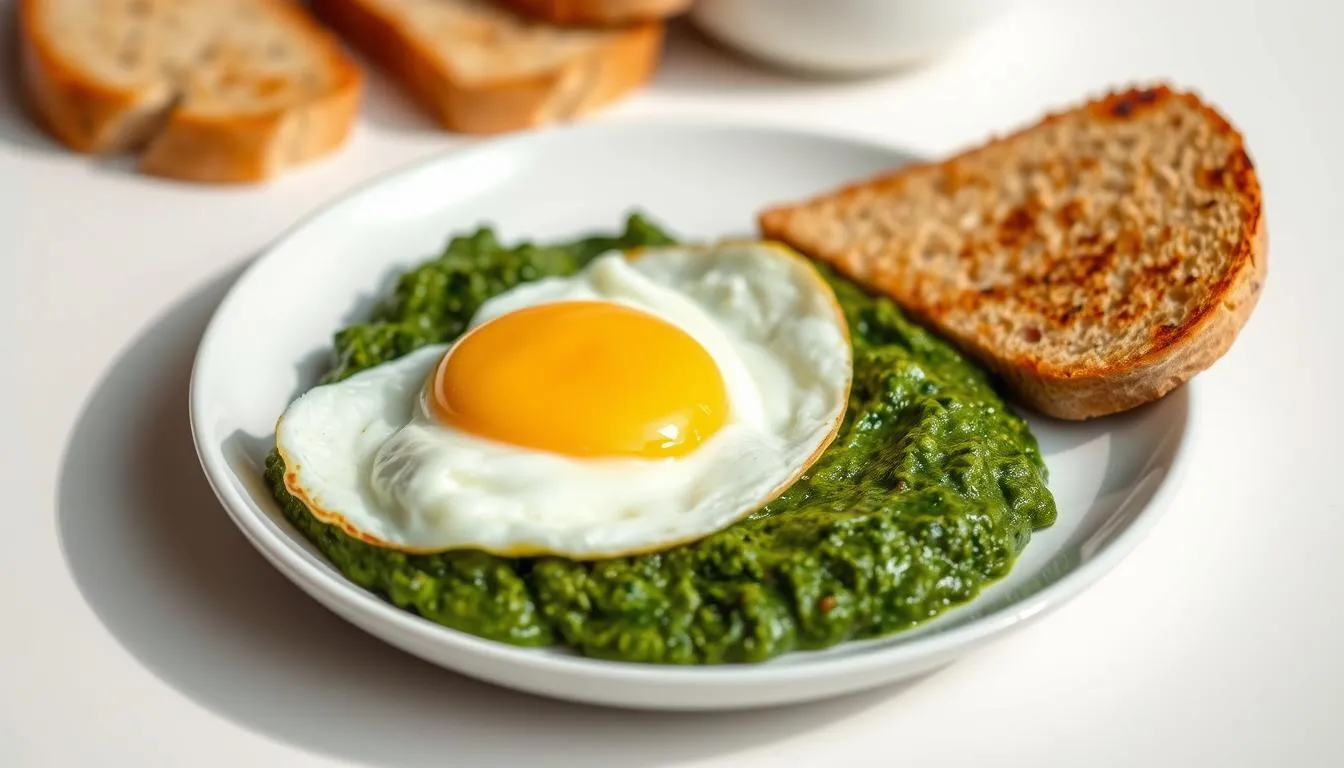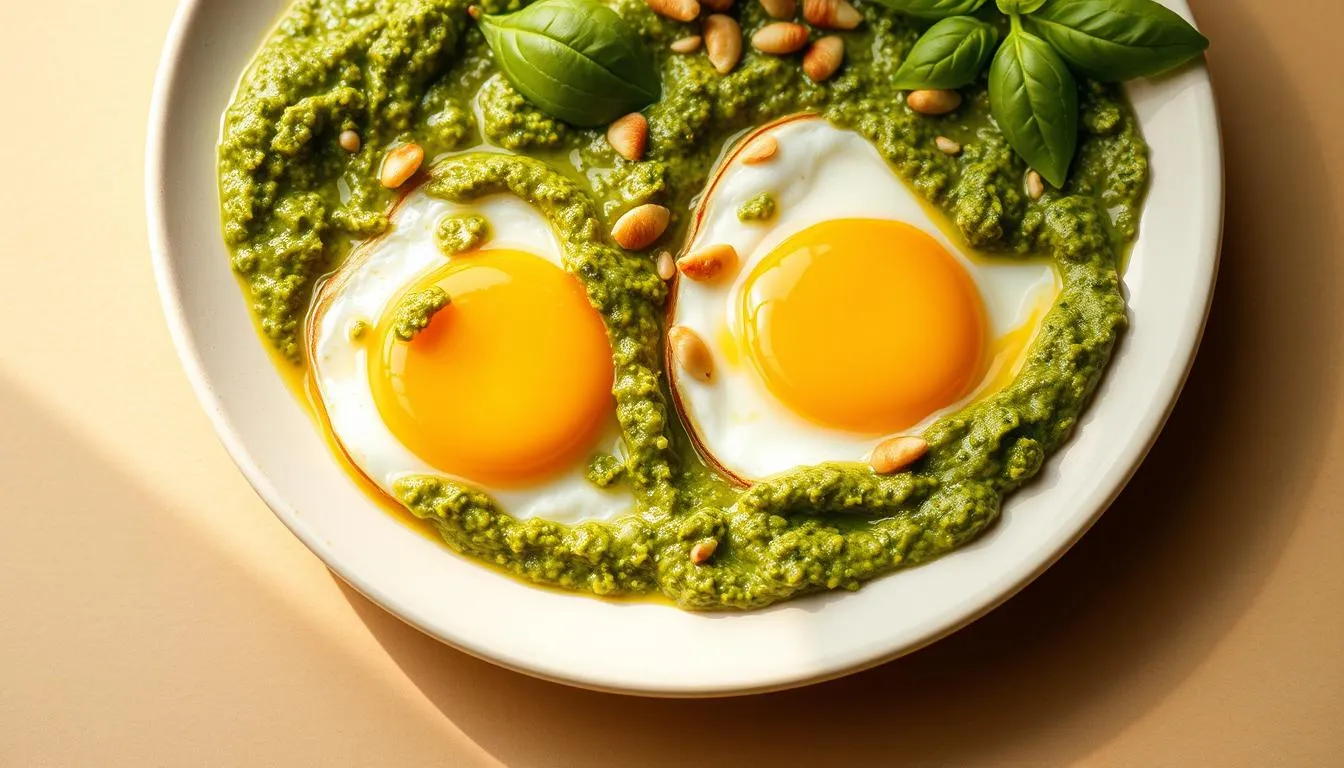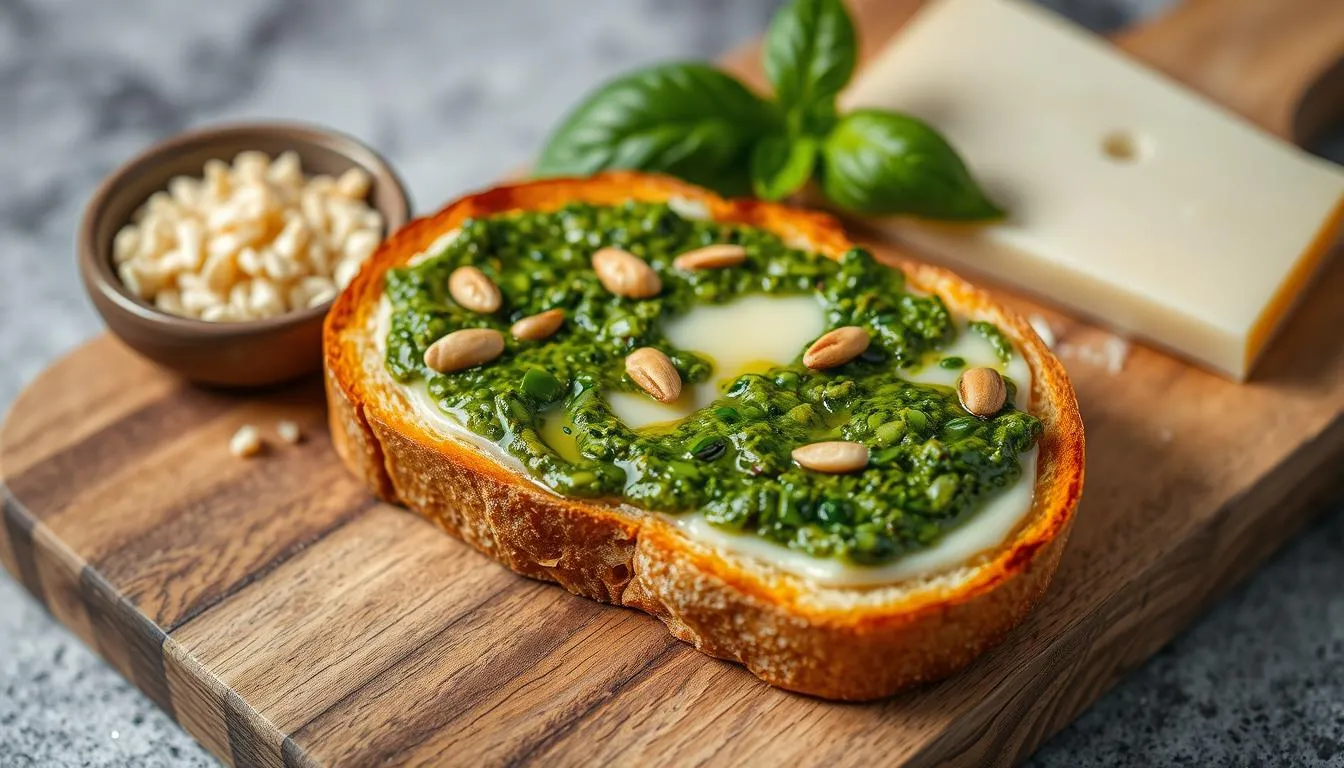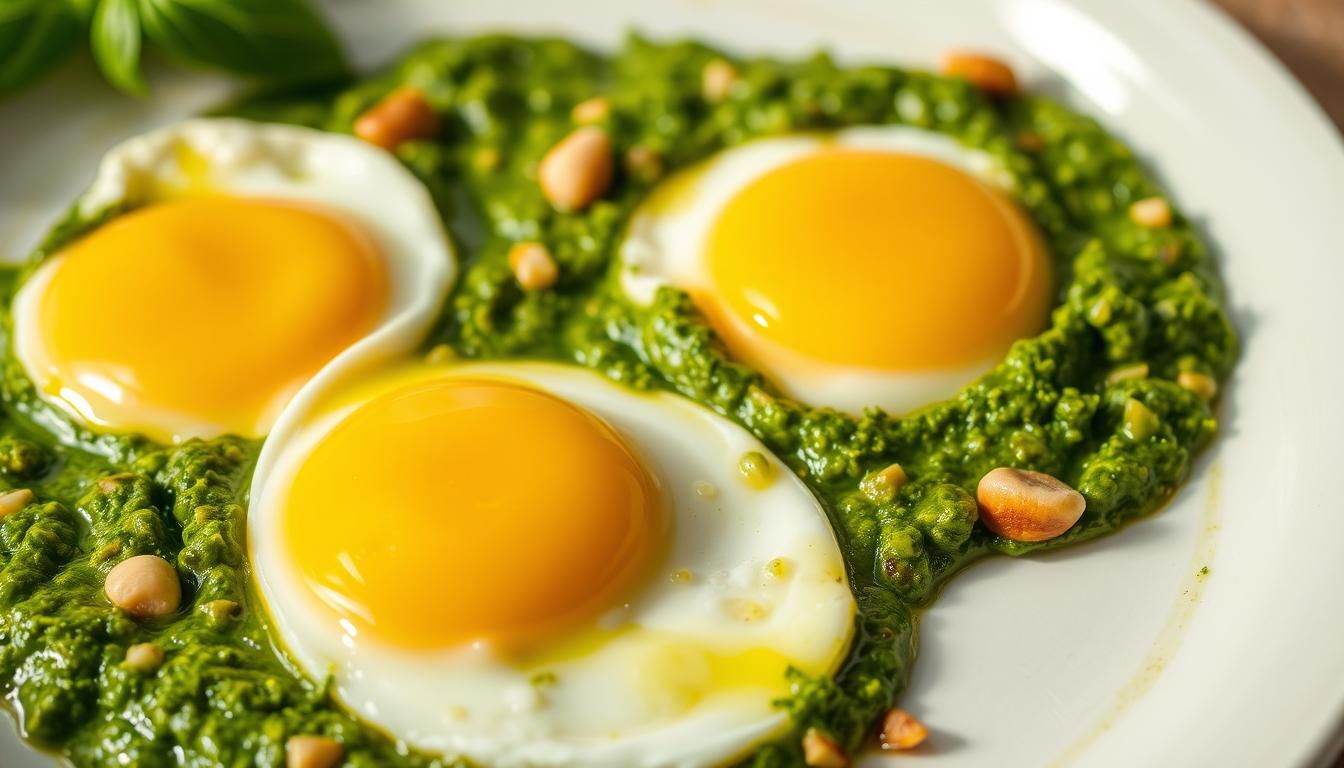Some mornings feel rushed, but you still want a meal that comforts and fuels you. This simple dish turns two pantry staples into a bright, café-style plate in about five minutes.
With just a spoonful of basil spread and two eggs, you can cook without added butter or oil. Season lightly with salt and pepper, add a pinch of chili if you like heat, and serve on toast for a quick, tasty start.
Prefer a little flair? Fry sunny-side-up over low heat in the herby oil, cover the pan for two minutes, then top toast with fresh mozzarella and tomato for a caprese twist.
This breakfast gives satisfying protein and can be kept light or made heartier with toppings. Looking for other quick breakfast ideas? Try our refreshing nature’s cereal recipe for a lighter option. The post that follows will show what to use, step-by-step cooking, and easy serving ideas so you can make this recipe any morning in minimal time.
Key Takeaways
- Ready in about five minutes — ideal for busy mornings.
- Relies on pantry staples so no big grocery run is needed.
- Basil-infused spread adds rich herb, garlic, and cheese notes.
- No extra butter or oil required thanks to the spread’s oil.
- Versatile: keep it simple or build a caprese-style toast.
- Provides protein and easy calorie options based on toppings.
Why Pesto Eggs Are the 5-Minute Breakfast You’ll Crave
One quick skillet move turns humble breakfast staples into a flavor hit.
Why this trend works: Concentrated basil pesto brings herbs, garlic, and cheese straight to the pan. It seasons quickly, so the dish needs no extra prep or long cook time.
Warm the basil pesto over low heat until it just bubbles. Add the eggs and cover the pan. In about two minutes the whites set and the yolks stay silky.

The quick-at-a-glance benefits
- Five-minute prep: warm, crack, cover, and serve.
- Flavor from the spread’s oil creates a crisp edge and savory bite.
- High in protein to keep you full through a busy morning.
- Scales easily for one or more servings without extra timing fuss.
| Feature | Why it matters | Typical time | Best pairing |
|---|---|---|---|
| Concentrated flavor | Herbs, garlic, and cheese in one spoon | Less than 1 minute to warm | Toast, mozzarella, tomato |
| Oil-based cook | Eggs fry gently in flavorful fat | 2–3 minutes to set whites | Sourdough or salad |
| Protein-packed | Keeps you full until lunch | Ready in ~5 minutes | Avocado or extra cheese |
Pesto eggs
Start by gathering a few simple pantry items so cooking is smooth and fast.
Ingredients and tools: a nonstick pan, basil pesto (homemade or store-bought), two eggs, and toast like whole wheat or sourdough. For a subtler finish use 1–2 tablespoons of pesto per serving. For a bold, saucy plate use 1/3–1/2 cup for two eggs.
Heat matters. Warm the basil pesto in a pan over low to medium heat until you see a gentle bubble. The oil in the spread cooks the egg whites without needing butter. Keep the flame low so herbs and cheese stay bright and don’t burn.
Quick tips
- Choose a pan size that fits the number of eggs so whites don’t run thin.
- Cover the pan after cracking eggs so steam sets the whites evenly.
- Prep toast or toppings while the pesto warms so everything is hot at once.
- Swap basil for sun-dried tomato pesto for a different flavor.
| Serving | Pesto amount | Heat | Result |
|---|---|---|---|
| Simple | 1–2 tablespoons | Low | Light coating, tender whites |
| Bold | 1/3–1/2 cup | Low to medium | Herby, saucy eggs |
| Tip | Adjust pan size | Pan medium heat when bubbling | Even cook, no scorching |
Want a full method? Try this pesto eggs recipe for step-by-step guidance.
Step-by-Step: Cook Eggs in Basil Pesto on Low or Medium Heat
Begin by heating the basil mixture just until it loosens and the oil begins to move. This gives you a clear visual cue that the pan is ready without burning herbs or cheese.

Warm the spread
Use a nonstick pan. Place the basil pesto over low or pan medium heat and watch for a gentle shimmer or slight bubbling. This takes only a minute or two and uses the spread’s oil—skip extra butter.
Crack and cover
Crack eggs directly into the pan. Immediately cover so steam helps the egg whites set evenly. For runny yolks, cook about 2 minutes; add time for firmer yolks.
Season and finish
Sprinkle salt and plenty of pepper. Add red pepper flakes or Aleppo pepper for heat. Spoon warm pesto over the top for an extra glossy finish just before plating.
Choose your style
For sunny-side-up, keep heat low and avoid flipping. For a crisper edge, let the eggs fry a bit before covering. For scrambled, stir slowly over low heat until softly set, then remove from heat.
| Style | Heat | Time | Result |
|---|---|---|---|
| Sunny-side-up | Low | About 2 minutes | Opaque whites, jiggly yolks |
| Fried (edges crisp) | Low to medium | 2–3 minutes | Golden edges, tender center |
| Scrambled | Low | 2–4 minutes | Soft curds, creamy texture |
Quick tips: Use visual cues—opaque whites and slightly jiggly yolks—to know when to stop. Keep the dial low to protect flavor and finish quickly so this recipe fits a busy breakfast routine.
Serve It Up: Toasts, Toppings, and Lower-Carb Ideas
Serve your skillet creation on warm slices for an effortless, café-style plate. A quick assembly makes the most of bright herb flavor and a runny yolk. Use warm bread to catch the sauce and keep textures balanced.

Caprese toast: mozzarella, tomato, and a drizzle of pan pesto
Build the stack: spread a spoonful of warm pesto on toast, layer fresh mozzarella and tomato slices, then slide the cooked eggs on top. Finish with another tiny spoon of pan pesto so everything glazes.
Sourdough with avocado: creamy, crunchy, and protein-packed
Smash avocado on toasted sourdough. Add a soft egg and crumble goat or ricotta cheese over the top. This gives creaminess, crunch, and extra protein without fuss.
No bread? Stack eggs on tomato and mozzarella slices
For a lower-carb plate, skip the bread. Layer tomato and mozzarella, set the eggs on top, and sprinkle basil and a pinch of pepper and red pepper flakes.
“Toast while the eggs cook so everything arrives hot and the yolk runs just right.”
- Create caprese toast with warm spread, mozzarella, tomato, then eggs.
- Finish with pepper and red pepper flakes to lift the cheese.
- Skip bread for a fork-and-knife stack of tomato, mozzarella, and egg.
- Try feta or goat cheese instead of mozzarella for tang or creaminess.
- Toast in halves or slices so the yolk spills across each bite.
Tips, Variations, and Nutrition at a Glance
Keep the stove low and patient—gentle heat protects bright herb flavor. That simple step prevents bitterness and keeps the spread glossy while the whites set.
Prevent burning: warm the basil pesto over low heat until it just shimmers. Use a small pan so the sauce doesn’t overreduce and the egg cooks evenly.
Cheese swaps: try feta, goat cheese, or ricotta to change saltiness and texture. Each cheese shifts the flavor—feta adds tang, goat adds cream, and ricotta softens the bite.
Quick make-or-buy notes
- Store-bought pesto saves time; homemade takes minutes in a food processor with basil, garlic, pine nuts, olive oil, and grated cheese.
- For a light finish use 1–2 tablespoons; for a saucier plate use up to 1/2 cup for two eggs.
- If you want more sauce, thin a spoonful with a teaspoon of warm olive oil before serving.
Nutrition and balance
A simple serving runs near 184 calories. Add mozzarella and toast and you’re close to 319 calories.
“Eggs supply protein while the basil spread supplies fat—pair with toast or greens to round out the meal.”
| Tip | Why | Quick numbers |
|---|---|---|
| Low heat | Prevents bitterness | 1–2 minutes to warm |
| Pesto amount | Light vs bold | 1–2 tbsp or 1/3–1/2 cup (for two) |
| Cheese swap | Change texture & salt | Feta, goat, or ricotta |
Conclusion
End with an easy finish: gentle heat, a cover, and a pinch of seasoning for a perfect bite.
Bring it all together, by warming the spread gently in the pan, adding the eggs, and covering until the whites set. Keep the flame at medium heat or lower so the herb oil stays bright and the flavor stays clear.
Salt lightly and finish with freshly cracked pepper. Serve on toast for a hearty breakfast or stack on tomato and mozzarella for a lower-carb plate.
Use this simple recipe again and tweak timing for your stove so results stay consistent and mornings stay easy.
FAQ
How long does it take to make this basil pesto and egg breakfast?
You can have a ready-to-eat plate in about 5–10 minutes if you use store-bought basil sauce; making a quick homemade version with a food processor adds 5–7 minutes. Cook time for the eggs on low to medium heat is typically 3–5 minutes, depending on doneness.
What heat level should I use so the sauce doesn’t burn but the egg whites set?
Use low to medium heat. Warm the sauce until it gently bubbles, then add the eggs and cover the pan. Low heat helps set whites without scorching the greens or olive oil.
How much of the basil mixture should I add per egg?
Start with 1 tablespoon per egg for a light flavor; for a richer taste, use up to 1/2 cup total for a two-egg skillet. Adjust to your preference and the saltiness of the cheese you plan to add.
Can I cook different egg styles in the same pan of warmed sauce?
Yes. Sunny-side-up and fried work well; for scrambled, fold in warmed sauce off heat to preserve aroma. If you want runny yolks, watch cooking time and keep the lid on just long enough to set whites.
Which cheeses pair best as toppings or swaps?
Crumbled feta, goat cheese, or grated Parmesan all complement the herb-forward sauce. Ricotta adds creaminess when spread on toast before topping with the eggs.
Is it better to make my own basil blend or buy prepared jars?
Both work. Homemade offers fresher flavor and control over salt and oil; commercial jars save time and are great for busy mornings. Choose a high-quality olive oil–based jar for best results.
What bread or low-carb options should I serve with this for breakfast?
Sourdough or a slice of toasted sourdough is classic. For lower-carb, serve eggs on avocado halves, grilled tomato slices, or a bed of sautéed greens.
How can I prevent the herb oil from separating or becoming greasy in the pan?
Warm the sauce gently and avoid high heat. If oil pools, reduce heat and stir briefly to reincorporate. Using a nonstick pan helps control sticking without adding extra fat.
Are there quick add-ins to boost protein or flavor?
Add sliced smoked salmon, cooked chickpeas, or a sprinkle of toasted pine nuts. A light dusting of red pepper flakes or freshly ground pepper lifts the dish without extra prep time.
How should I season to balance salt and fat from the sauce and cheese?
Taste a small spoonful of the sauce before cooking to judge salt level. Add a pinch of kosher salt to the whites if needed, then finish with cracked black pepper or red pepper flakes for brightness.
